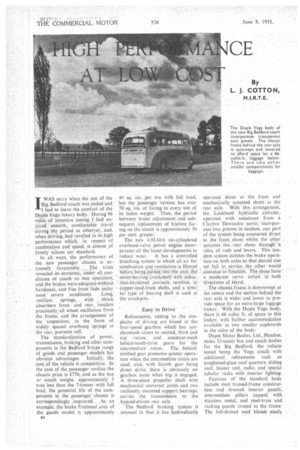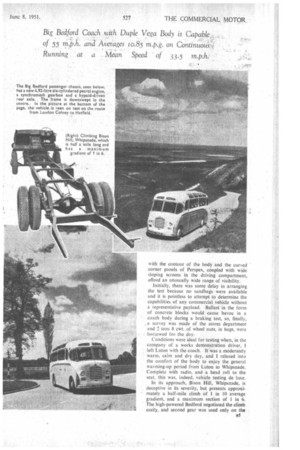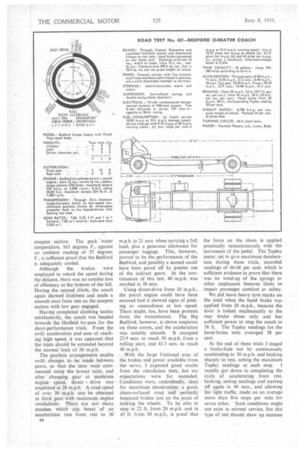CE
Page 38

Page 39

Page 40

Page 41

If you've noticed an error in this article please click here to report it so we can fix it.
By L. J. COTTON, m.i.R.T.E.
IWAS sorry when the test of the °Big Bedford coach was ended and I had to leave the comfort of the Duple Vega luxury body. During 96 miles of intensive testing 1 had enjoyed smooth, comfortable travel during my period as observer,, and, when driving, had revelled in its high performance which, in respect of acceleration and speed,, is, almost of family saloon car standard.
In all ways, the performance of the new passenger chassis is extremely. favourable. ..., The trials revealed its.ecortoriiy,:imder all conditions of coach or -bus Operation,' and the brakes were adequate withenit harshness, and free from fade under most severe conditions. Long, resilient springs, . with shack absorbers front and rear, insulate practically all wheel oscillation from the frame, and the arrangement of the suspension, in the form of widely spaced overhung springs at the rear, prevents rot!.
The standardization of power, transmission, braking and other components in the Bedford S-type range of goods and passenger models has obvious advantages. initially, the cost, of the vehicle is competitive. In the case of the passenger version the chassis price is £770, and as the bus or coach weighs approximately 3 tons less than the 7-tonner with full load, the potential life of the components in the passenger chassis is correspondingly improved. As an example, the brake frictional area of the goods model is approximately 49 sq. ins, per ton with full load, but the passenger version has over 70 sq. ins, of facing to every ton of its laden weight. Thus, the period between brake adjustment-and subsequent replacement of friction facing on the coach is approximately 50 per cent. greater. .
The new 4.92-litre six-cylindered overhead-valve' petrol engine incor-porates all the latest developments to
reduce wear. It has a controlled breathing system in which all air for combustion and ventilation is filtered before being passed into the unit, the seven-bearing 'crankshaftviiith tion-haidened, journals revolves in Copper-lead-lined shells, and -a simi lar type of bearing shell is used at
the crankpins. • : Easy to Drive .
Refinements, adding to. the simplicity of driving are •found in the four-speed gearbox which has synchromesh cones to second, third and top ratios, and constant-mesh helical-tooth-form gears for the intermediate ratios. The helicaltoothed gear promotes quieter operation when the intermediate ratios are used, and, with fourth gear being direct drive, there is obviously no gearbox noise when top is engaged. A three-piece propeller shaft with mechanical universal joints and two resiliently mounted support bearings, carries the transmtssion to the hypoid-clriven rear axle. • The Bedford braking • system is unusual in that it has hydraulically
operated shoes at the front and mechanically actuated shoes at the rear axle. With this arrangement, the Lockheed hydraulic cylinder, operated with assistance from a Clayton Dewandre servo; incorporates two pistons in tandem, one part of the system being connected direct to the front shoes whilst the other actuates the rear shoes thiangh-a relay of rods and levers. This tandem system isolates the brake operation on both axles so that should one set fail in service the other would continue to function The shoes have a moderate servo action in both directions of travel.
,The chassis frame is down swept at the centre and the section behind the rear axle is wider and lower to provide space for an extra-large luggage locker. With the Duple Vega body, there is 66 cubic ft. of space in this locker, with further accommodation available in two smaller •cupboards in the sides of the body.
Duple Motor Bodies, Ltd., Hendon, make 33-seater bus and coach bodies for the Big Bedford, the vehicle tested being the Vega coach with additional refinements such as toughened-glass roof quarters, sliding roof, heater unit, radio, and special tubular racks with interior lighting.
Features of the standard body include steel trussed-frame construction and stressed interior panels, intermediate pillars capped with stainless metal, and steel-truss and racking panels riveted to the frame. The full-domed roof blends nicely
with the contour of the body and the curved corner panels of Perspex, coupled with wide sloping screens in the driving compartment, afford an unusually wide range of visibility.
Initially, there was some delay in arranging the test because no sandbags were available and it is pointless to attempt to determine the capabilities of any commercial vehicle without a representative payload. Ballast in the form of concrete blocks would cause havoc in a coach body during a braking test, so, finally, a survey was made of the stores department and 2 tons 8 cwt. of wheel nuts, in bags, were borcowed for the day.
Conditions were ideal for testing when, in the company of a works demonstration driver, I left Luton with the coach. It was a moderately warm, calm and dry day, and I relaxed into the comfort of the body to enjoy the general warming-up period from Luton to Whipsnade. Complete with radio, and a head roll to the seat, this was, indeed, vehicle testing de luxe.
In its approach, Bison Hill, Whipsnade, is deceptive in its severity, but presents approximately a half-mile climb of 1 in 10 average gradient, and a maximum section of 1 in 6. The high-powered Bedford negotiated the climb easily, and second gear was used only on the
steepest section. The peak 'water temperature, 163 degrees F., against an ambient reading of 55 degrees F., is sufficient proof that the Bedford is adequately cooled.
Although the brakes were employed to retard the speed during the descent, there was no notable loss of efficiency at the bottom of the hill. During the second climb, the coach again showed liveliness and made a smooth start from rest on the steepest section with low gear engaged.
Having completed climbing tactics satisfactorily, the coach was headed towards the Hatfield by-pass for the short-performance trials. From the swift acceleration and' ease of reaching high speed, it was apparent that the trials should be extended beyond the normal limit of 30 m.p.h.
The gearbox arrangements enable swift changes to be made between gears, so that the tests were COMmenced using the lowest ratio, and after changing gear at moderate engine speed, direct drive was employed at 28 m.p.h.' A road speed of over 30 m.p.h.' can be obtained in third gearrwithmaximum engine reVolutions: There are not' many coaches which can boast !of an' acceleration rate from rest to 30
a6 m.p.h. in 21 secs. when carrying a full load, plus a generous allowance for passenger luggage. This, however, proved to be the.performance of the Bedford, and possibly a second could have been pared off by greater use of the indirect gears. In the continuation of this test, 40 m.p.h. was reached in 38 secs.
Using direct-drive from 10 m.p.h., the petrol engine could have been excused had it showed signs of pinking or unsteadiness at low speed. There might, too, have been protests from the transmission. The Big Bedford, however, is above suspicion on these scores, and the acceleration was notably smooth. It occupied 23.9 secs. to reach 30 m.p.h. from a rolling start, and 41.3 secs. to reach 40 m.p.h.
.With the large frictional area of the brakes and power available from the servo, I expected good results from the retardation tests, but my expectations were far exceeded. Conditions were, undoubtedly, ideal for maximum deceleration; a good, clean-surfaced road and perfectly balanced brakes just on the point of locking the wheels. To be able to stop in 22 ft. from 20 m.p.h. and in 45 ft. from 30 rn.p.h., is proof that the force on the shoes is applied practically instantaneously with the movement of the pedal. The Tapley meter, set to give maximum deceleration during these trials, recorded readings of 66-68 per cent, which i4 sufficient evidence to prove that there was no wind-up of the springs or other unpleasant features likely to impair passenger comfort or safety.
We did leave heavy tyre marks on the road when the hand brake was applied from 20 m.p.h., because the lever is linked mechanically to the rear brake shoes only and has sufficient power to stop the coach in 38 ft. The Tapley readings for the hand-brake tests averaged 38 per cent.
At the end of these trials I staged a brake-fade test by continuously accelerating to 30 m.p.h. and braking sharply to rest, noting the maximum Tapley readings at each stop. I rapidly got down to completing the cycle of accelerating from rest, braking, noting readings and starting off again in 40 secs., and allowing for light traffic, made on an average more than five stops per mile for seven miles. Such conditions might not exist in normal service, but this type of test should show up increase )f pedal travel or tendency to brake 'ade.
Starting with readings of 63-65 per tent., the first 20 stops, occupying 13 mins., showed no increase of recial travel or difference in etfici:ricy. After 27 emergency applicaions, the efficiency dropped by 5 per tent., but this was imperceptible to he driver. Soon afterwards, the iedal travel increased slightly, but tfter 36 stops in 35 mins. the efficiTicy reading had fallen to only 50 )er cent. I consider this to be a iotable achievement in brake design, specially because the hand brake vas still effective when tested with kot drums at the end of the trials.
After this came the petrol-con: umption test, made over a 2I-mile
tit-and-return course, involving the limbing of Welwyn Hill in both irections. As a coach operating in lit country, it might be driven at speeds exceeding the legal limit, therefore, for the first run a speed of 35-40 m.p.h. was set to emulate normal practice. There was an average amount of main-road traffic during the trial, and, because of road work in progress, early use of indirect gears was required on the hill. Even so, the average speed worked out to 33.5 m.p.h., thereby reflecting credit on the flexibility of the engine. The consumption rate was 10.85 m.p.g. Incidentally, the vehicle milometer passed the 3,000 mark during the earlier part of this trial, and all the usual precautions, including changing oil at the prescribed intervals, had been taken during the running-in period.
With one stop per mile, and using the calculator stop-watch to measure the time when the vehicle was moving, the average speed worked out to 28 m.p.h. and the fuel consumption at the rate of 9.3 m.p.g., thus indicating that the Bedford can operate a fast urban service without being expensive in fuel.
Operating a schedule, with stops every 400 yds., the fuel return was 6 m.p.g. Considering the average heavy oil-engined single-decker would use a gallon of fuel to every 8 miles under similar conditions, the Bedford Duple 33-seater bus, costing £2,145, should represent an attractive proposition to many operators of provincial and town services.
My tests completed, I drove the coach back to Luton and indulged in a high-speed run on the way. On level ground, the speedometer needle crept up to 55 m.p.h., and had conditions permitted, I think the Bedford could have been encouraged to reach a mile a minute.
I returned the coach to the works satisfied in every way with the performance of the chassis and comfort of the vehicle as a whole. There are two minor points which might come in for criticism, one being the position of the hand-brake lever, and the other the clearance below the skirt of the body. Where the vehicle is employed in a hilly area on bus operation which calls for frequent use of the hand brake, it may be necessary to set-up the lever for more comfortable manipulation.
The clearance of the body will he adequate for normal operation on the roads, but where the vehicle is engaged on hire work and required to be driven off the road, the skirt clearance may prove to be inadequate..•




















































































